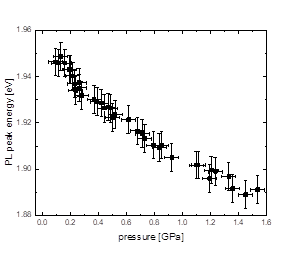Reports: ND656595-ND6: Pressure Response of Organic Photonic Materials at the Nano- and Mesoscale
J. Mathias Weber, University of Colorado, Boulder
Scientific Progress: Work was performed throughout the year, although the graduate student mainly working on the project (James Curtis Beimborn II) was only available full-time for this project in the summer of 2017. Synthesis attempts to create perylene crystals in specific polymorphs following literature procedures yielded only mixtures of polymorphs, which were not sufficiently pure in either polymorph type to allow work on a pure sample.
In the meantime, we have constructed a hydraulic pressure apparatus (materials funded from other sources), which is able to reproducibly generate pressures up to ca. 500 MPa without the need to use ruby fluorescence for pressure measurement. This enables much finer resolution and better control over pressures in this lower pressure range. This apparatus will be particularly advantageous for the (relatively soft) organic materials we target in this project, which are likely to have phase transitions in this pressure region.
We have started to study the pressure behavior of the photophysics of the indigo derivative cibalackrot (see Figure 1), which was synthesized by the group of Josef Michl (Department of Chemistry, University of Colorado, Boulder). Cibalackrot displays interesting photophysical characteristics for singlet fission, and is highly stable under ambient conditions. It exhibits two polymorphs at ambient conditions, but its pressure behavior is unknown so far. We have performed photoluminescence (PL) spectroscopy as a function of pressure with several forms of cibalackrot using illumination at 532 nm:
· powder samples suspended in paraffin (crystallized from solutions) in a diamond anvil cell (DAC);
· films prepared by sublimation in a DAC with paraffin as pressure medium;
· a 100 mM solution of cibalackrot in THF (i.e., on monomers in solution) in a hydraulic pressure apparatus;
Figure 1. Structure of cibalackrot.
The different preparations show different PL spectra at ambient pressure (see Figure 2). However, all exhibit a main peak, followed by a shoulder at longer wavelengths. In the solution, this shoulder is followed by an additional shoulder at even longer wavelengths, and the features are expected to be due to the Franck-Condon envelope. However, residual aggregation may also be underlying some of this structure, although solutions at 0.1 mM concentration showed the same spectrum as at 100 mM. The long-wavelength features in films are much broader than in solution. Interestingly, the PL peak wavelength for the powder sample is much different than for the other two preparations. This difference may be due to polymorphism, and XRD measurements to clarify this point are under way.
Figure 2. Photoluminescence spectra of cibalackrot in different morphologies. From top to bottom: Solution, film, powder (see text).
With increasing pressure, the photoluminescence peaks shift to the red for all samples (see Figure 3), but the shifts do not exhibit the same slopes. At low pressures (up to ca. 0.3 GPa), these shifts are -86 meV/GPa for monomers in THF, -110 meV/GPa for powder, and 27 meV/GPa for films. At higher pressures, the pressure induced shifts are less pronounced (-35 meV/GPa for powder, -10 meV/GPa for films, respectively). These differences in behavior point to the importance of morphology for the photophysics of this material.
For the powder sample, dE/dP abruptly changes near 300 MPa, which may be due to a solid-solid phase transition that changes the coupling strength between neighboring molecules. A similar transition is observed for the films, but the film spectra are broad at ambient pressure and sharpen significantly at high pressures, providing additional evidence pointing to a solid-solid phase transition.
Powder and film samples were studied in the DAC, and experiments in the hydraulic apparatus will yield better information on such possible transitions at low pressure. These experiments are under way, as are pressure measurements on solutions of cibalackrot monomers in the DAC. We hope to finalize the work on cibalackrot in the coming months and publish the results in 2018.
We will also continue our efforts to produce polymorph-specific samples for perylene and rubrene and characterize their polymorphs and the associated pressure behavior.
Figure 3. Pressure dependence of PL peak energies of cibalackrot powder (left) and film (right) samples.
Impact: The PRF-funded research has opened an avenue for the PI to branch out into materials research, particularly regarding relatively soft material. The work on cibalackrot also opens a new direction of its own, since this material is of interest in the context of singlet fission, and may lead to future collaborations with groups working in this area. The research supported by this grant will constitute a significant part of the thesis of the graduate student participating in this project, and the grant provides an important of the student’s support.















